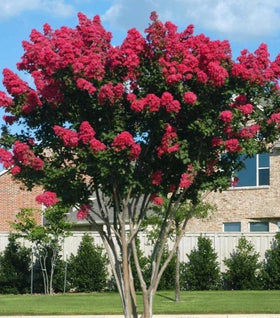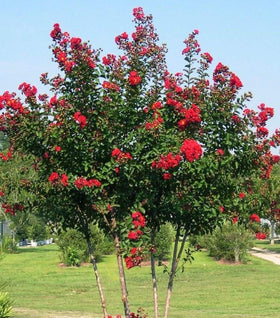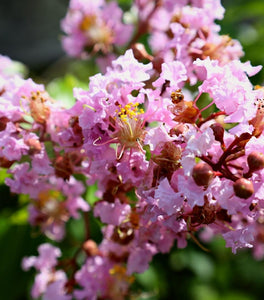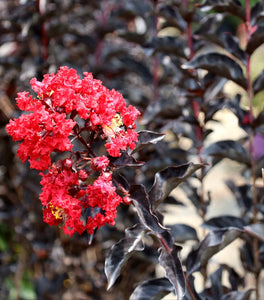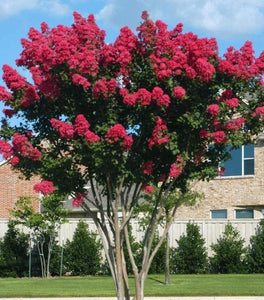Images Depict Mature Plants
Colorama™ Scarlet Crape Myrtle Trees for Sale Online
Colorama™ Scarlet Red Crape Myrtles live up to their name with a lively array of bright scarlet red flowers If you look closely, you can see a mix of lighter and deeper reds within the flower clusters. Enjoy this explosion of color every summer and fall with this low-maintenance specimen tree. Crepe Myrtle trees make wonderful focal points in a yard, and the Colorama™ Scarlet is no exception. They are heat, drought, and deer resistant but are very bird and pollinator-friendly. Their bright golden fall foliage and dynamic brown and cinnamon-colored winter bark give this show-stopping tree year-round interest.
| Hardiness Zone: | 6-10 |
|---|---|
| Mature Height: | 15 to 20 Feet |
| Mature Width: | 8 to 12 Feet |
| Habit: | Upright, multi-trunk tree form, deciduous |
| Sunlight: | Full sun |
| Flower Color: | Scarlet red flower clusters |
| Blooms: | Summer through to late fall |
| Foliage: | Glossy green, orange-red in the fall |
| Soil Condition: | Any well-drained soil |
| Water Requirements: | Water well until established |
| Uses: | Extremely attractive when used as a focal point in the mixed border, mass planting, or a specimen planting. Also try them in large containers on the patio |
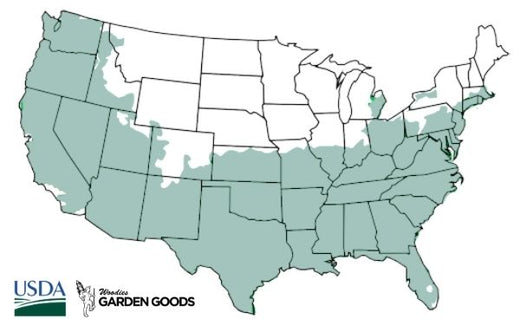
How to Care for Colorama Scarlet Red Crape Myrtle
Be sure to read our planting instructions to ensure a healthy and happy plant for years to come!
How often do I water my Scarlet Red Crape Myrtle?
Although fairly drought tolerant, the cold hardy Scarlet Red tree thrives in moist soil. Water young trees twice a week for up to a year until it is well established. After that, reduce your watering to once a week, depending on your local climate and recent weather. When in doubt, test the nearby soil and water if the top three inches are dry to the touch. We recommend watering for 5 seconds per gallon size of the nursery pot (at least while the tree is young). A 1 gallon pot needs 5 seconds from a typical garden hose, a 3 gallon pot needs 15 seconds, etc.

How do I prune Colorama Scarlet Crepe Myrtles?
Since Crape Myrtles typically have several trunks, leave them intact, but remove suckers (extra limbs growing from beneath the ground). Scarlet Crape Myrtle trees, similar to other crape myrtles, bloom on new wood, therefore we recommend pruning in late winter to very early spring at the latest. Once spring growth has begun you should wait until next winter unless necessary. When pruning a young tree, you can remove excess limbs, or branches that are dead, dying, or diseased. Over-pruning can be harmful to the tree, it is better to shop for a Crape Myrtle that is the right size for your space, and prune sparingly.
What kind of soil is best for my Red Crape Myrtles?
Colorama Scarlet Crape Myrtles are not picky and can thrive fairly well in most soil conditions. With that said, they prefer slightly acidic, well-drained soil. If you decide to fertilize your tree, opt for a multi-purpose, slow-release fertilizer and apply once early in the spring. A common myth is that heavy fertilizing will increase the abundance of blooms. However, giving your tree too much fertilizer will support foliage growth, at the expense of your blooms. When it comes to the Crape Myrtle, less is more. Test your soil before planting and use a starter fertilizer or soil amenders ahead of time - this strategy can mean less need to fertilize as the tree grows since it had the chance to become well established in healthy, balanced soil.
How do I plant Colorama Scarlet Crape Myrtles?
Colorama Crape Myrtles prefers full sun, so it is best to pick a spot where it can receive at least 6 to 8 hours of direct sun. Dig a hole in your garden that is wider, but no deeper than the container your plant came in. After placing your tree in the hole, fill the remaining space with a 50/50 mix of the soil you removed earlier and organic matter (such as topsoil and peat moss for nutrients and drainage), and pack down gently. Do not plant your tree too deeply and do not cover any of the multiple trunks with soil. Once this is complete, give your tree a good watering and cover with 2 to 3 inches of organic mulch, such as pine bark. It is important to leave a gap between the mulch and the trunks to prevent root system rot and disease. The mulch will also help to maintain moisture and protect the roots from harsh winter months.









